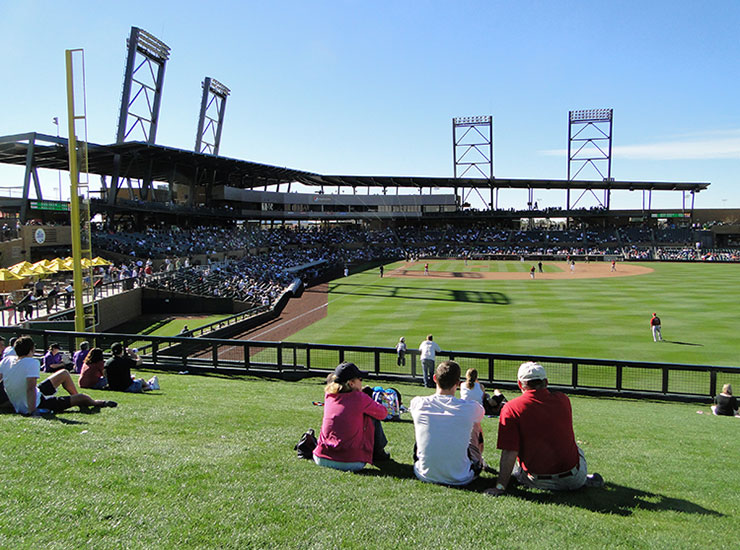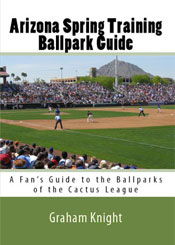
|
As long as the Arizona Diamondbacks and Colorado Rockies have been in existence they have trained in Tucson. Collectively, the two clubs spent 31 springs in The Old Pueblo, their ballparks separated by just five miles, but more than 100 miles from every other team in the Cactus League.
That distance ultimately spelled doom for Tucson, the site of the first Cactus League game on March 8, 1947. In 2011, the Arizona-based spring training circuit will experience another first when the league’s newest ballpark and complex opens on Native American soil, thereby becoming the first major league spring training facility to stand on tribal land. Officially named Salt River Fields at Talking Stick, the $100 million complex is being financed by the Salt River Pima-Maricopa Indian Community on their land just east of Scottsdale that’s alongside the Loop 101. The Indian Community’s willingness to build and the D-backs and Rockies willingness to inhabit a joint complex meant spring training died in Tucson on March 31, 2010, when the two soon to be partners faced each other at Hi Corbett Field, the Rockies a 4-3 winner before a send-off crowd of 6,817. Crowds are expected to be much larger in 2011 at Salt River Fields, which will have an 11,000 person capacity with room for 7,000 fans in the grandstand and 4,000 more spread out a berm that will be spring training’s biggest. Fan friendliness and comfort will be the hallmarks of the complex that was designed by HKS Architects, the same firm that did Glendale’s Camelback Ranch, which served as a model for the Dallas-based architectural firm’s second spring training ballpark. Just like at the Glendale complex, walking trails will weave through parking lots to the main stadium, which is surrounded by a dozen full-sized practice fields and four half fields. Those fields will be accessible to fans thanks to the trail system that navigates the 140 acres of former golf course property that is on schedule to be completely transformed by January 28, 2011. When finished, "it's going to be as fan-friendly an experience as you will find in the game,” D-backs President and CEO Derrick Hall told MLB.com on November 16, 2009, which was the date the tribes and teams broke ground on the venture that was given the name Salt River Fields at Talking Stick on June 4, 2010. Outside of the main stadium, fans will be able to walk alongside players as they walk to their practice fields and clubhouses, which for the Diamondbacks organization will be in the left field corner. The Rockies’ clubhouse will similarly occupy the right field corner. The signature feature of the reason that most fans will come to visit Salt River Fields, the stadium, is the uniquely designed roof that will shade the majority of its grandstand. The roof has two panels that overlap behind home plate and are positioned so that 85% of all fans in the grandstand will be shaded during the course of the afternoon, when most Cactus League games are played. The grandstand will have 28 rows, with 16 of them above a cross aisle. At the typical first pitch time of 1:05 almost all seats within those 19 sections of 16 rows will be shaded by the roof that is designed to resemble a ramada. Below the cross aisle are 23 sections of no more than a dozen seats, with the upper two-thirds of them benefiting from the late arriving shade. As is custom, the general admission berm will be sun-drenched and split into two sides by the batter’s eye building in straightaway center field. Like most Cactus League parks, the Salt River Fields stadium’s outfield dimensions are deep, with the foul poles 345 feet from the plate that is 410 feet from center field. By comparison, the other nine stadiums in the league average 346’ to left, 348’ to right and 411’ to center. As you can see, those measurements are almost identical to Salt River Fields, which like many other facilities in the Cactus League will offer fans panoramic views of the desert mountain ranges that Arizona is notable for. Eschewing the typical, Salt River Fields will lack a façade at its main, behind home plate entrance, where trees in a plaza will be the only visual impediment between the inside and outside of the stadium. Nearby the landscaped plaza is a stream that connects to a three-acre fish-stocked lake that provides irrigation for the entire complex, a feature that was a novel idea when introduced at Camelback Ranch. Because of the stream, all fans who enter Salt River Fields at its home plate gates first cross over a wide pedestrian bridge. Fans will be crossing that bridge for at least the next 25 years, the length of the lease that the Diamondbacks and Rockies signed with the Salt River Pima-Maricopa Indian Community to end a 63-year spring training tradition in Tucson. While the partnership between Arizona and Colorado’s baseball teams are new, the Pima-Maricopa combination dates to 1879. Much more recently, the Indian Community has aggressively developed the area around the spring training complex, which is about a mile from their Talking Stick Resort and Casino Arizona, both of which opened in 2010, and the Talking Stick Golf Club, established in 1997. Come 2011, baseball will be added to the tribes’ portfolio of entertainment options under their Talking Stick banner, and as a result the Cactus League’s transformation into an exclusively Phoenix-based league will be complete.

Salt River Fields Facts, Figures & Footnotes
Salt River Fields FirstsOfficial ballpark firsts (all of which occurred on 2/26/11, unless noted):
| ||||||||||||||||||||||||||||||||||||||||||||||||


